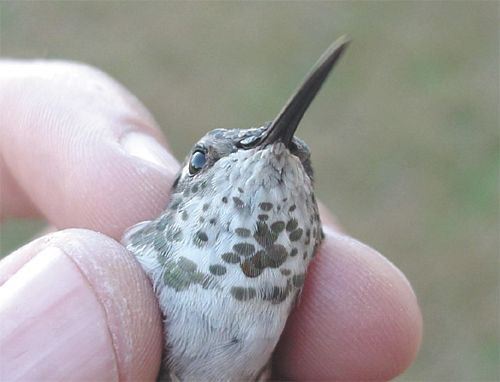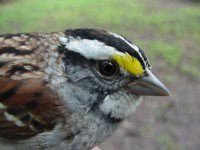|
|
|||
|
|
THIS WEEK at |
|
|
|||
|
|
THIS WEEK at |
|
Rufous Hummers Aren't Supposed Although we could spend several lifetimes studying natural wonders that abound on just 11 acres at Hilton Pond Center, we occasionally wander elsewhere in the Piedmont. Such was the case this week when we journeyed again to Casar, North Carolina--about 60 miles to the north--to investigate a "vagrant winter hummingbird" visiting a feeder maintained by Wayne and Colleen Girard. 
All photos & text © Hilton Pond Center We met the Girards in February 2001 when Colleen called about a hummer that had visited her feeder all winter. In the Carolinas, winter hummingbirds are an anomaly; the Ruby-throated Hummingbird, Archilochus colubris, is our only breeding species, and virtually all of them depart by mid-October for warmer climes in Mexico and Central America. The few ruby-throats that overwinter in the southern U.S. are usually found in coastal areas, so any Piedmont winter hummer is likely to be one of several western species known to wander eastward.
Most female Rufous Hummingbirds-- especially adults--bear several green or bronze metallic markings on the gorget (top photo), while female Ruby-throats of any age almost never have dark throat feathers. Female Rufous Hummingbirds also show some degree of rusty coloration at the base of the tail; often this is not viewable unless the bird is in the hand. There are unquestionably more winter hummingbirds being reported in recent years throughout the eastern U.S. What is not known is whether the increase is due to a change in hummingbird dispersal and migration behavior, or whether there are so many more pairs of human eyes watching winter hummingbird feeders--most of which traditionally had been taken down in early October. We do know that hummingbirds make a living being curious, whether it's probing a bright new flower in your garden or exploring some untapped territory for an appropriate place to breed or overwinter.
It's fascinating enough that the Girard's Rufous Hummingbird has made the trip to Casar in successive winters, but this bird revealed another interesting tidbit this week. Maybe in a few hundred more years we humans finally will begin to understand hummingbirds and bird migration in general--certainly one of the biggest mysteries of animal behavior. For future understanding to occur, we need a lot more data points, so it's important that folks in the eastern U.S. who see hummingbirds between mid-October and mid-March report their sightings immediately. Now if one of those wayward winter hummers would just stop by Hilton Pond Center and fill the void our Ruby-throated Hummingbirds left when they bailed out in September. Previously, we HAVE banded Rufous Hummingbirds as close as 10 miles from here, but what we really want for Christmas is a wintering hummingbird to call our own. Hear that, Santa? All text & photos © Hilton Pond Center NOTE: Be sure to scroll down for an account of all birds banded or recaptured during the week, as well as some other interesting nature notes. "This Week at Hilton Pond" is written and photographed by Bill Hilton Jr., executive director of Hilton Pond Center for Piedmont Natural History. You may wish to consult our Index of all nature topics covered since February 2000. You can also use the on-line Search Engine at the bottom of this page. For a free, non-fattening, on-line subscription to "This Week at Hilton Pond," just send us an E-mail with Subscribe in the subject line. Please be sure to configure your spam filter to accept E-mails from hiltonpond.org. |
|
Make direct donations on-line through
Network for Good: |
|
|
LIKE TO SHOP ON-LINE?
Donate a portion of your purchase price from 500+ top on-line stores via iGive: |
|
|
Use your PayPal account
to make direct donations: |
|
|
SPECIES BANDED THIS WEEK American Goldfinch--2 NOTABLE RECAPTURES |
 On average since 1982 we've banded 74 per year; each winter always brings several returns (see left below)
WEEKLY BANDING TOTAL 7 species 29 individuals YEARLY BANDING TOTAL (2001) BANDING GRAND TOTAL |
|
Up to Top of Page Current Weather Conditions at Hilton Pond Center |
 "HUMMINGBIRD MORNINGS" "HUMMINGBIRD MORNINGS"In 2001, informative and entertaining hummingbird banding presentations were held at four Carolinas locations for more than 500 participants. For more info, and especially if your group would like to host "Hummingbird Mornings" in 2002, click on the hummingbird drawing at left. |
 post questions for The Piedmont Naturalist |
Join the |
Search Engine for |
|
|